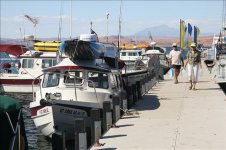The Bravo 12 HPP is an excellent pump and can be utalized for a 11.5 PSI high pressure floor boat if possible. It basically has two stages--one is high volume, and will blow an inflatable in a couple of minutes. Then it goes into its adjustable stage--and you can set the pressure with a dial from 2.5 PSI on up to 11.5 PSI. 4.5 PSI is one of these settings. This is a higher quality pump and will last for many years.
The recharbable low volume pumps are not really suitable for inflatables, The volume is just too low--air matress maybe OK...
If you have SS bows on a Bimini, especially with a 4 bow system, you can rest the back of a longer inflatble on the top of the bimini. I would put a piece of soft foam between the inflatable and the top, to prevent any chafe.
Electric trolling motors. If you use the salt water series, and wrinse them off, then they will last a long time. The biggest problem is the battery, and how to recharge it when cruising. If you are only going to use the trolling motor for a day or two--then you can charge it off a 110 volt charger. It can be very hard on the battery, trying to charge it in parallel with the larger engine or house battery of the C Dory, off the 12 volt system. (one should only charge batteries of like size on the charging circuit)
I took our 12 foot aluminum boat with has a 48 lb thrust salt water series trolling motor (8 years old and still working well) along this week when taking the grand kids cruising. I also had a 3.5 hp outboard. The trolling motor will give about 3 knots, and several hours total time--but this is with two golf cart batteries (220 amp hours). A 40 hour AGM battery (such as a tractor or PWC battery) would only give you hald an hour use at full power, and slightly longer at lower speeds. Back to my warning about enough power if the wind comes up--with an inflatable (no matter how narrow) you can be in trouble with the low HP motor. OK if you are never in wind or current.
I recommend an AGM battery, since you don't want to spill the acid of a conventional flooded battery in an inflatable! Also you need a small battery because of the weight. I have used the small batteries as starting batteries on 15 and 25 hp outboards on inflatables, with no problems, but would not use a lead acid battery.





